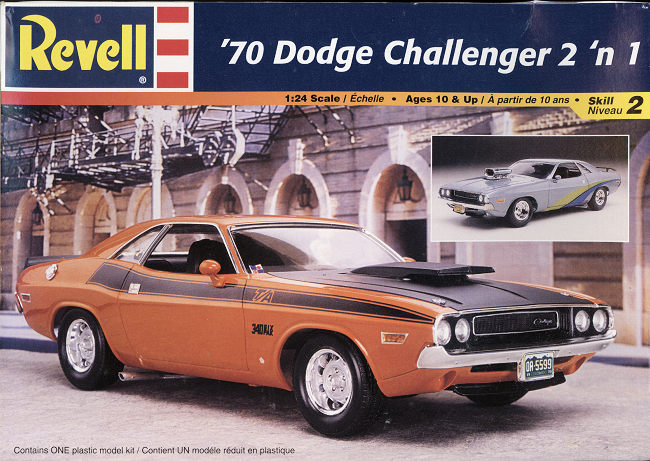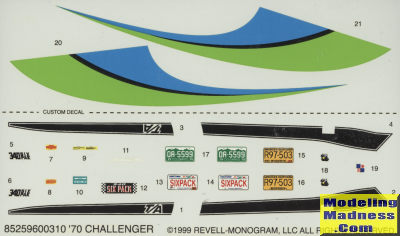
Revell 1/25 '70 Dodge Challenger
| KIT #: | 2596 |
| PRICE: | $ |
| DECALS: | Two options |
| REVIEWER: | Scott Van Aken |
| NOTES: | 1999 boxing |

| HISTORY |
Introduced in the autumn of 1969 for the 1970 model year, the Challenger was one of two Chrysler E-body cars, the other being the slightly smaller Plymouth Barracuda. Positioned to compete against the Mercury Cougar and Pontiac Firebird in the upper end of the pony car market segment, it was "a rather late response" to the Ford Mustang, which debuted in April 1964. Even so, Chrysler intended the new Challenger as the most potent pony car ever,[9] and like the less expensive Barracuda, it was available in a staggering number of trim and option levels, and with virtually every engine in Chrysler's inventory.
The first usage of the "challenger" name was for a trim package in 1959 called the Dodge Silver Challenger which was a two-door coupe only.
The Challenger's longer wheelbase, larger dimensions, and more luxurious interior were prompted by the launch of the 1967 Mercury Cougar, likewise, a bigger, more luxurious, and more expensive pony car aimed at affluent young American buyers. The 110 in (2,800 mm) wheelbase was 2 in (51 mm) longer than the Barracuda's, and the Dodge differed substantially in its sheetmetal, much as the Cougar differed from the shorter-wheelbase Mustang. Air conditioning and a rear window defogger were optional. With 1971 being the sole exception, the front ends of both cars differed from each other in that the Challenger had four headlights and the Barracuda had only two; a trend replicated by offerings from Chrysler's rivals.
The exterior design was penned by Carl Cameron, who was also responsible for the exterior designs of the 1966 Dodge Charger. Cameron based the 1970 Challenger grille on an older sketch of a stillborn 1966 Charger prototype that was to have a turbine engine. The pony car segment was already declining by the time the Challenger arrived. Sales fell dramatically after 1970, and though sales rose for the 1973 model year with over 27,800 cars being sold, Challenger production ceased midway through the 1974 model year. A total of 165,437 first-generation Challengers were sold.
A second generation car was basically a rebadged Mitsubishi Gallant that only lasted four years. In 2008, the car was reintroduced and kept in production until 2023 when it was again discontinued as a general American auto maker's trend to get away from sedans and become all truck/SUV manufacturers.
| THE KIT |
It is fairly obvious that Revell kept many of the Monogram tool makers when they combined the companies in the 1990s. This one has a bit of flash on some parts, but is otherwise superbly done.
As is usual with most US car kits, you get a full chassis onto which you install the suspension and engine. The body is a single piece with a separate hood, front, and rear insert for the grille and tail light assembly. There is a single piece for the windscreen and backlight. Headlights are also on the clear sprue. Unlike many kits, there is no red sprue for the tail lights. Instead a clear piece is provided and you are expected to paint the back of it red. The tub interior has the rear seat molded in place and there are inserts for the inner door panels along with the usual bucket seats, dash panel and steering wheel.
 The kit is
fairly light on optional bits. You have a choice of two engines. One is a stock
version and another has dual four barrel carburetors. This has a large oval air
scoop or a pair of velocity stacks. The other option is a modern looking wing in
place of the kit's spoiler for the rear trunk. That is it.
The kit is
fairly light on optional bits. You have a choice of two engines. One is a stock
version and another has dual four barrel carburetors. This has a large oval air
scoop or a pair of velocity stacks. The other option is a modern looking wing in
place of the kit's spoiler for the rear trunk. That is it.
Instructions are nicely drawn and provide generic paint references. Decals are for a stock Challenger T/A and include a variety of license plates. Also included is a large 'swoop' decal for the second engine option. Decals are a bit on the thick side, but history has shown that they will work quite well.
| CONCLUSIONS |
This looks to be a very nice kit. It is interesting that Scalemates, which is usually pretty good at providing info on kits, makes no mention of this boxing at all and instead lists a 2008 release of the 440 powered car as a 'new tool'. Obviously this one predates that, so they need to do a bit more research. Well worth picking up if you like the car.
| REFERENCES |
https://en.wikipedia.org/wiki/Dodge_Challenger
July 2023
Copyright ModelingMadness.com. All rights reserved. No reproduction in part or in whole without express permission from the editor.
If you would like your product reviewed fairly and fairly quickly, please contact the editor or see other details in the Note to Contributors.